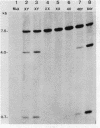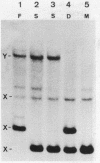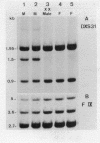Abstract
An X linked human DNA fragment (named DXS31 ) which detects partially homologous sequences on the Y chromosome has been isolated. Regional localisation of the two sex linked sequences was determined using a panel of rodent-human somatic cell hybrids. The X specific sequence is located at the tip of the short arm ( Xp22 .3-pter), i.e. within or close to the region which pairs with the Y chromosome short arm at meiosis. However the Y specific sequence is located in the heterochromatic region of the long arm ( Yq11 -qter) and lies outside from the pairing region. DNAs from several XX male subjects were probed with DXS31 and in all cases a double dose of the X linked fragment was found, and the Y specific fragment was absent. DXS31 detects in chimpanzee a male-female differential pattern identical to that found in man. However results obtained in a more distantly related species, the brown lemur, suggest that the sequences detected by DXS31 in this species might be autosomally coded. The features observed with these X-Y related sequences do not fit with that expected from current hypotheses of homology between the pairing regions of the two sex chromosomes, nor with the pattern observed with other X-Y homologous sequences recently characterized. Our results suggest also that the rule of conservation of X linkage in mammals might not apply to sequences present on the tip of the X chromosome short arm, in bearing with the controversial issue of steroid sulfatase localisation in mouse.
Full text
PDF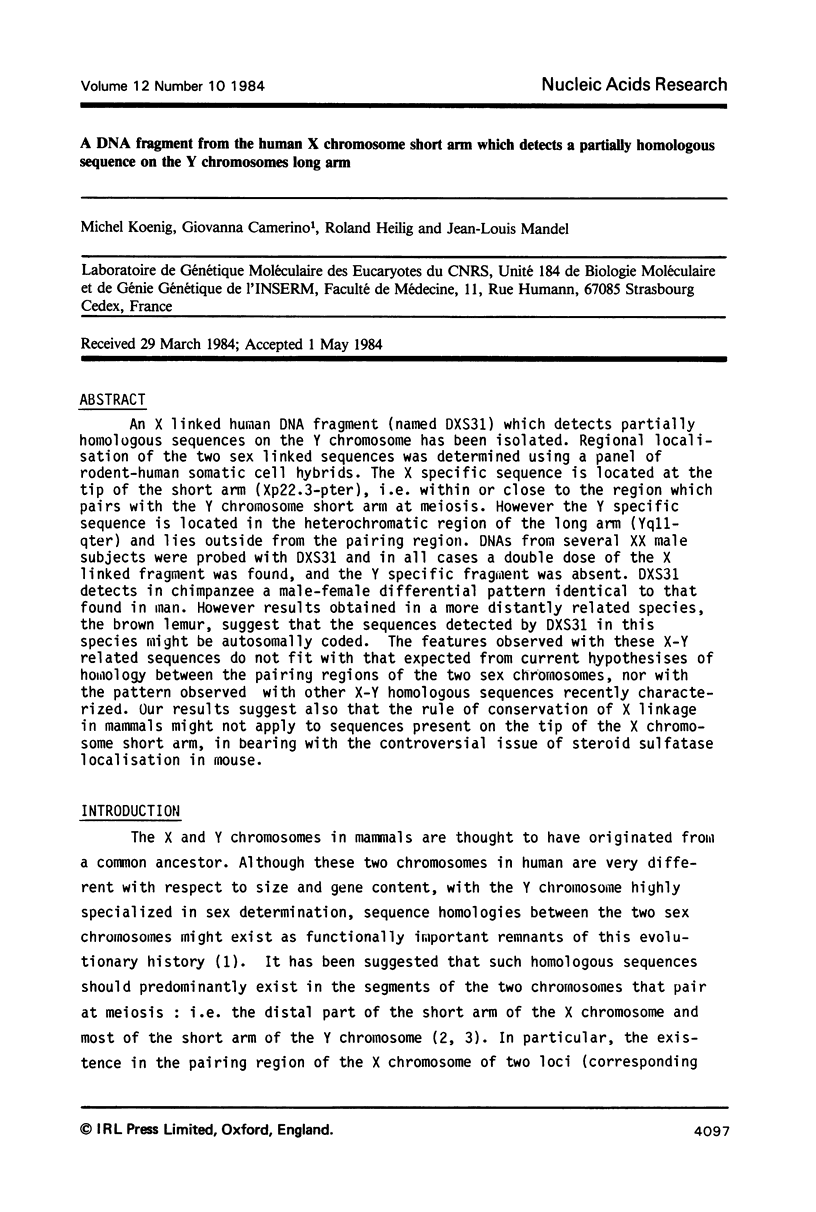
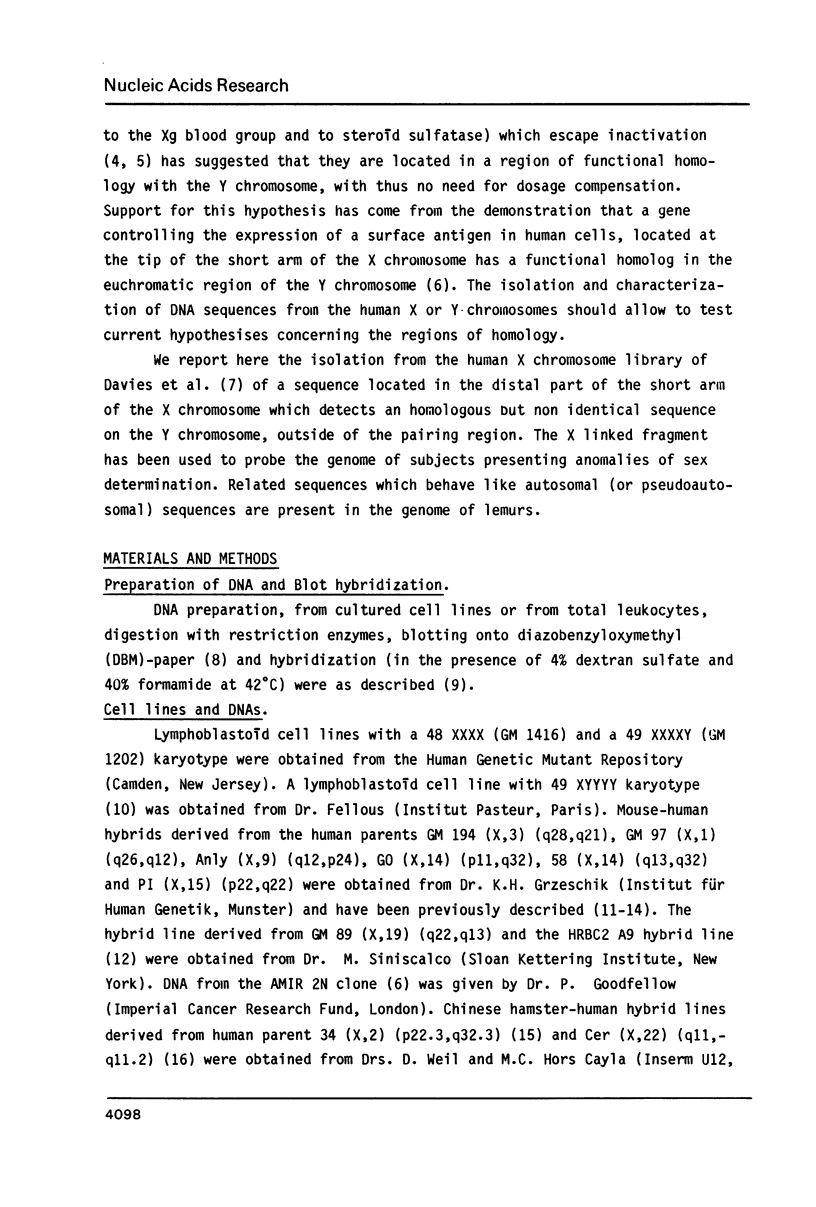
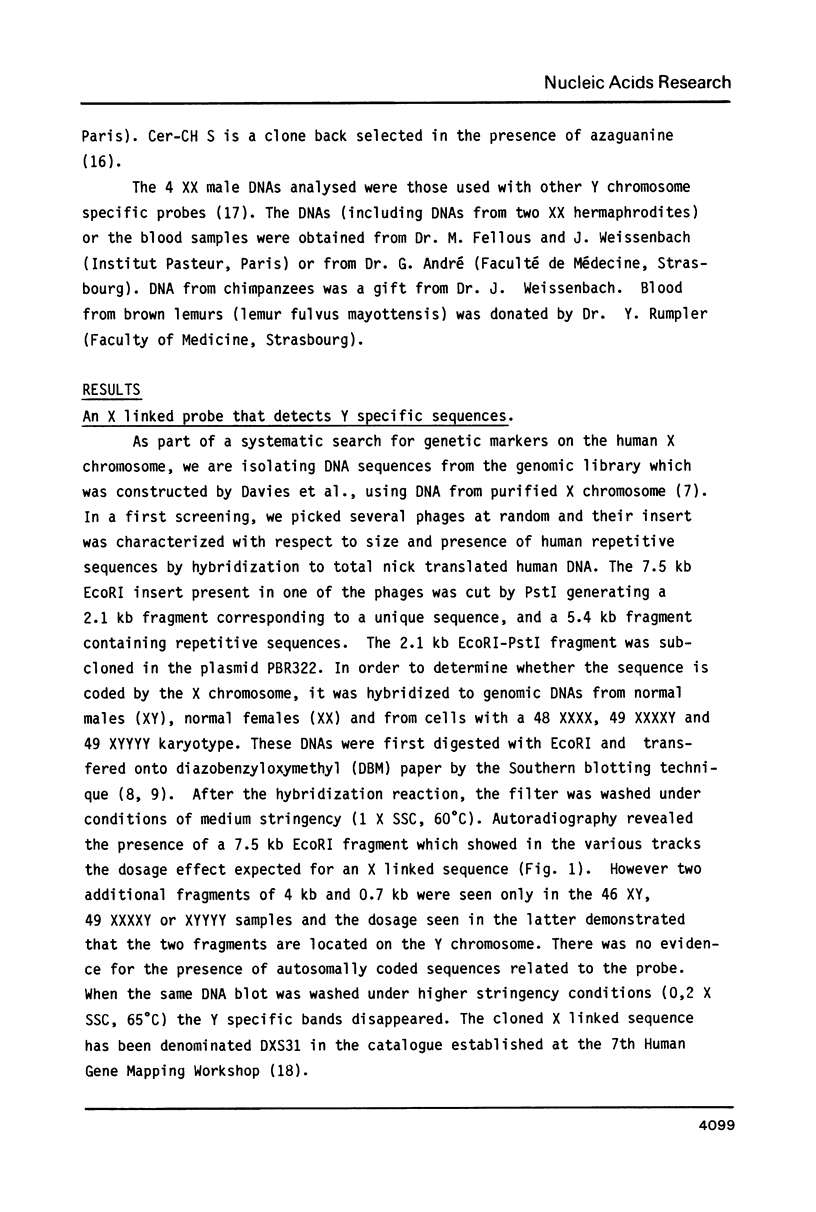
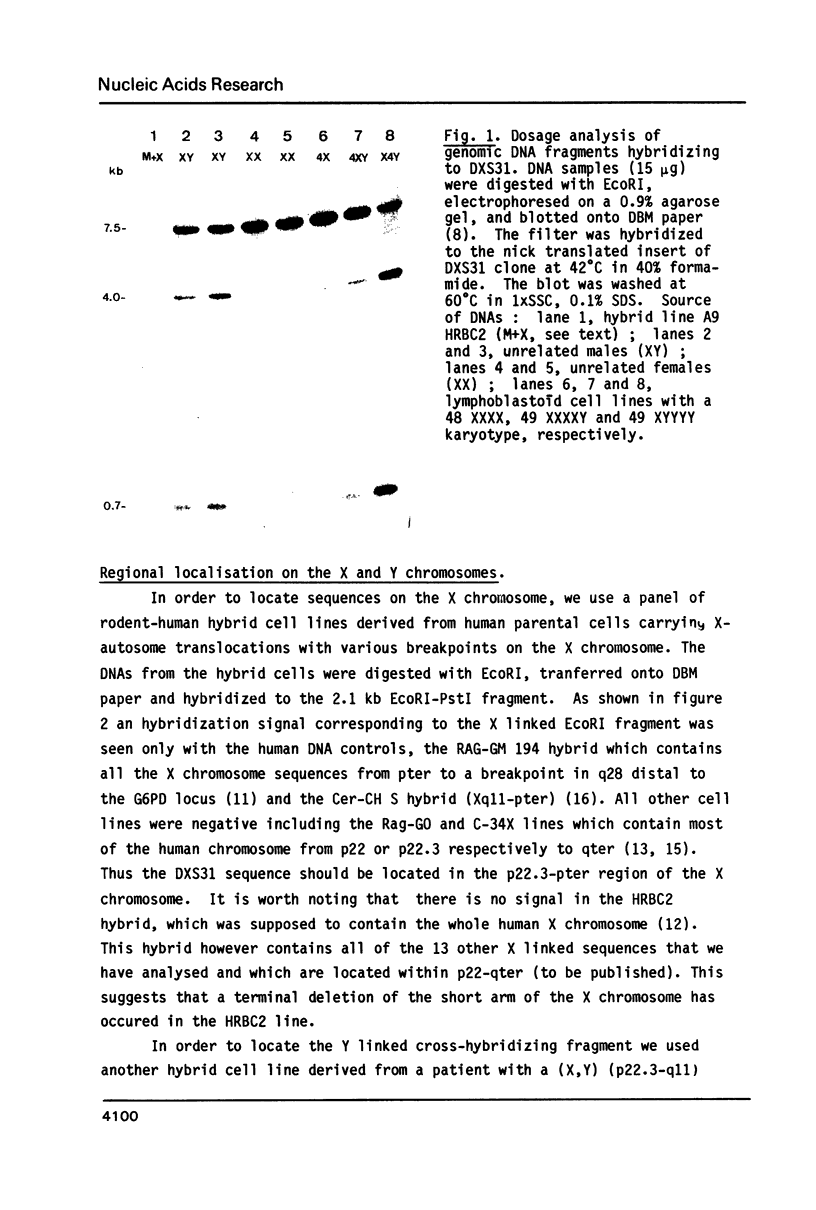
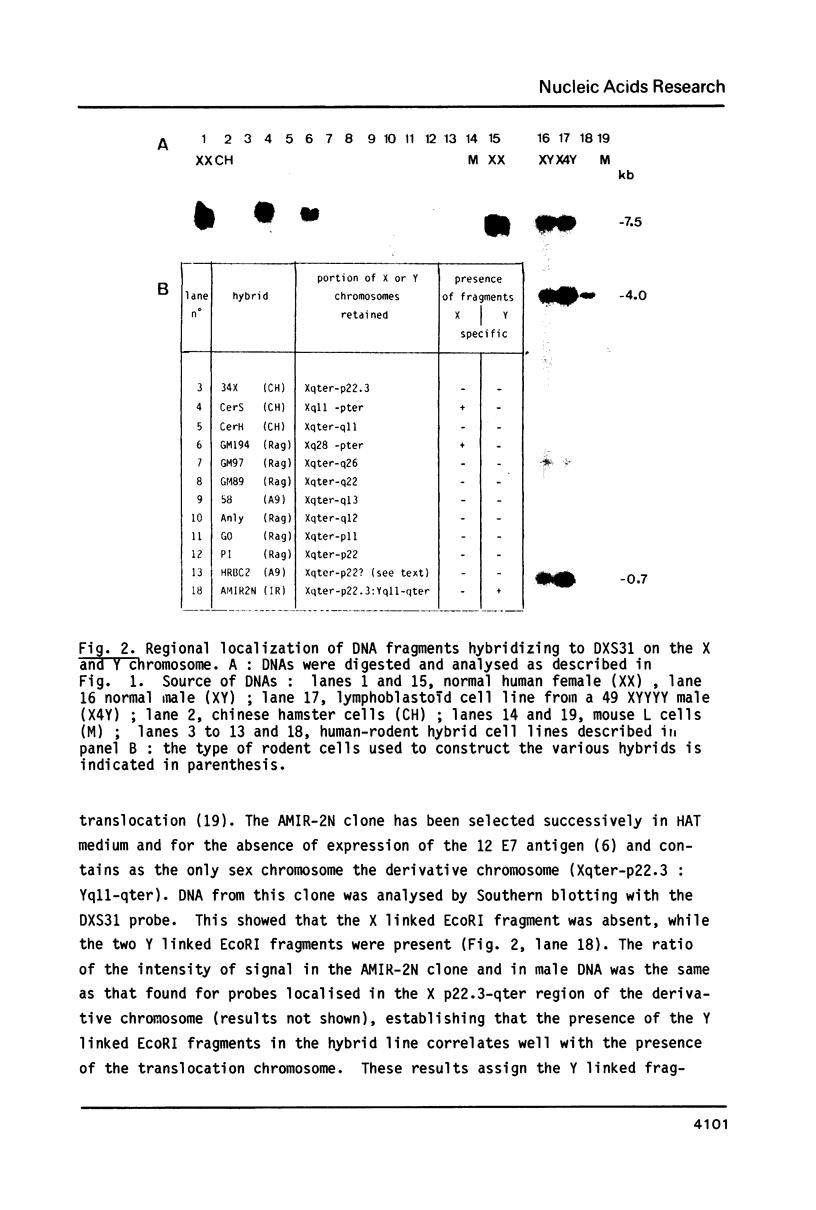
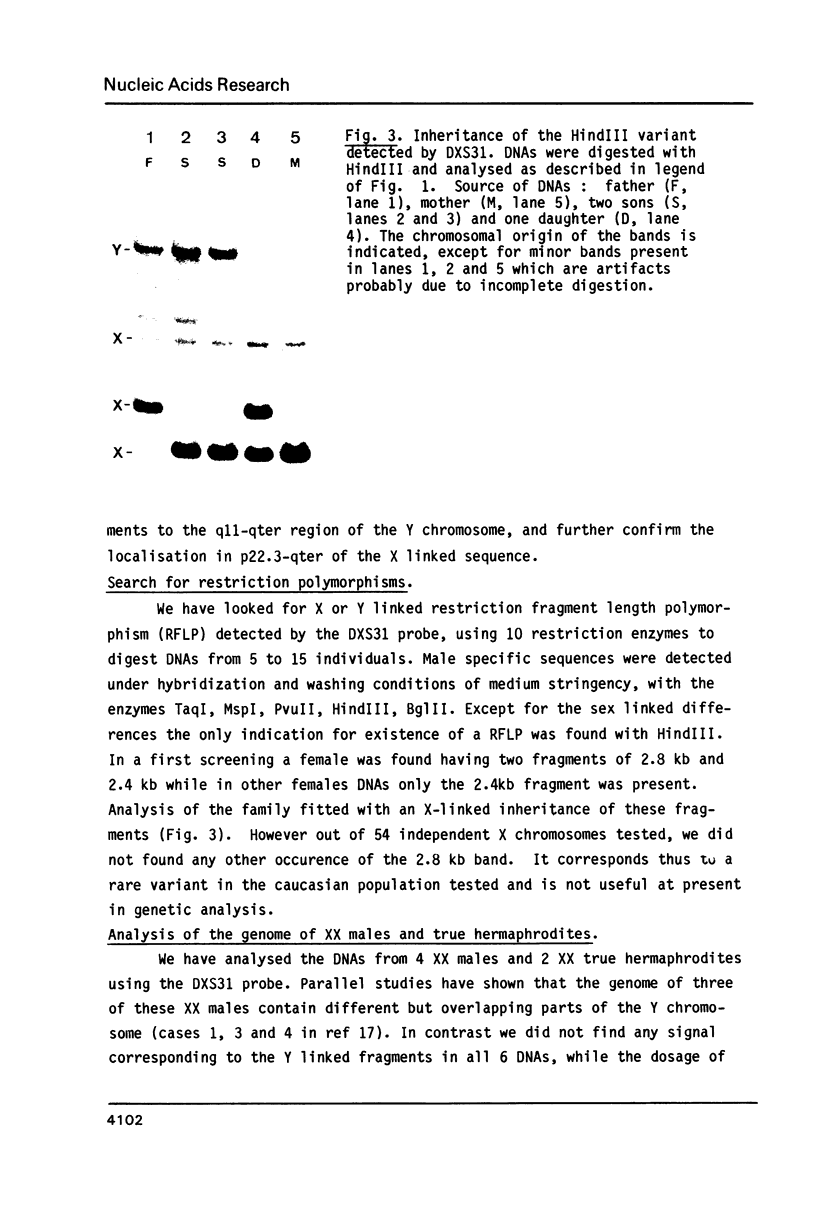
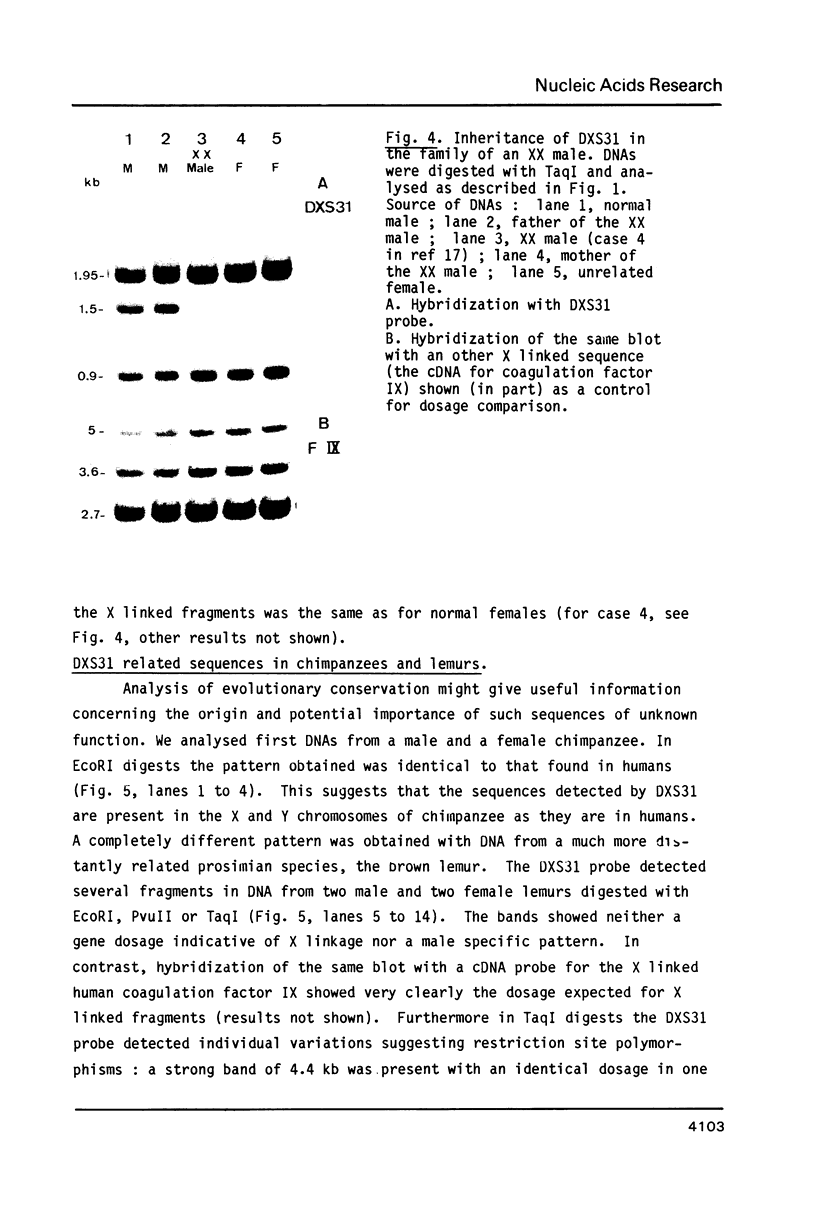
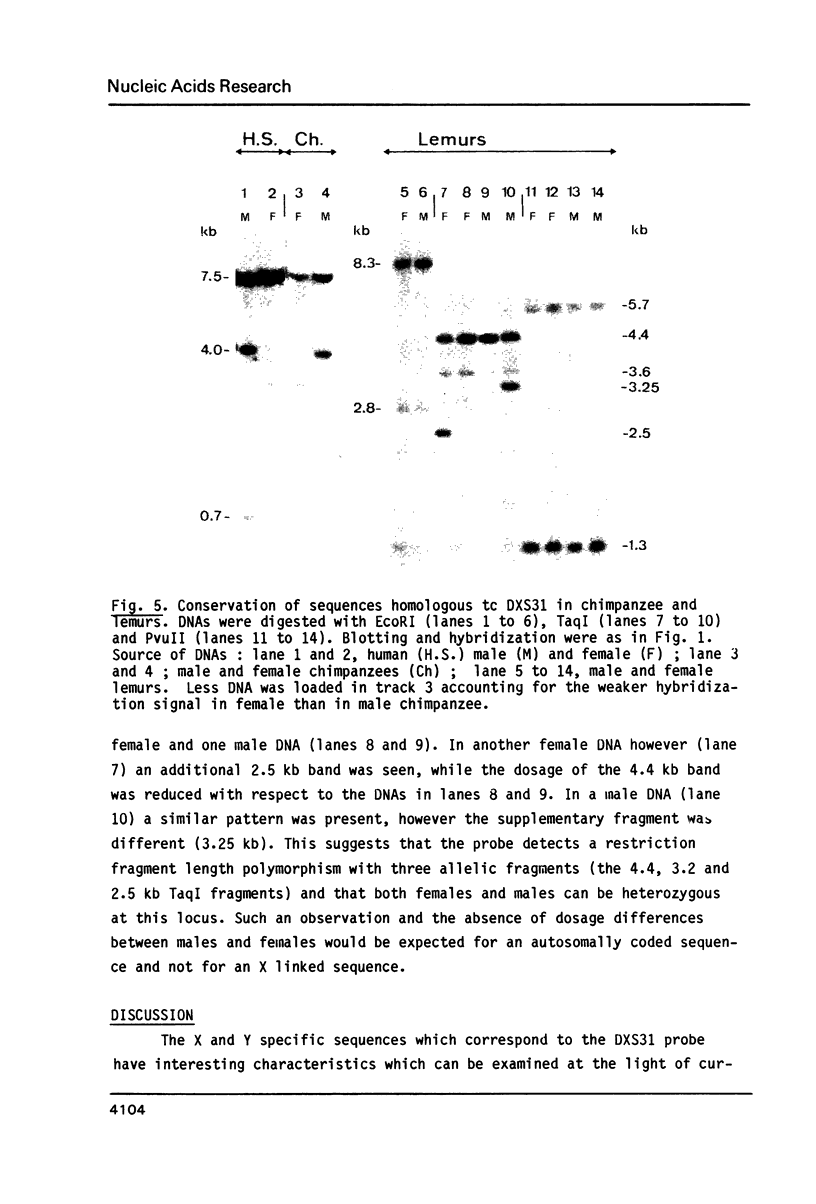
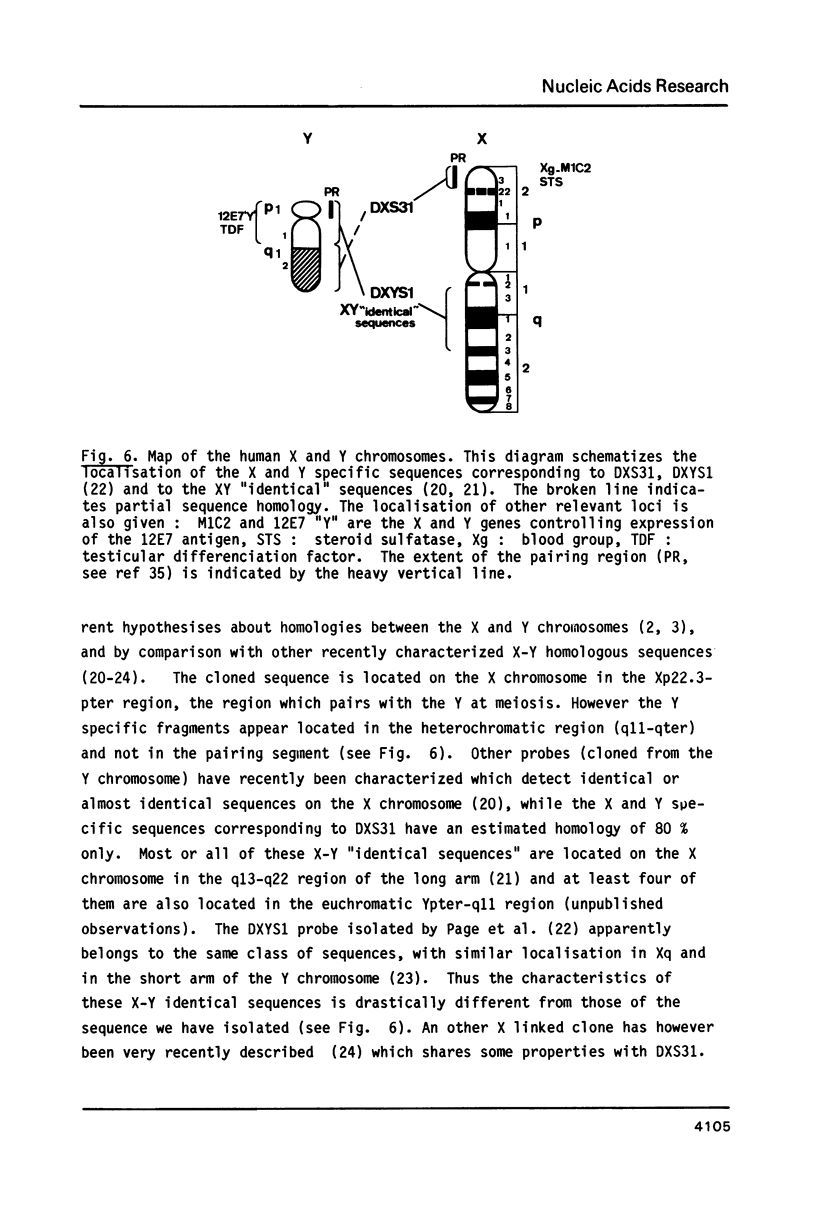
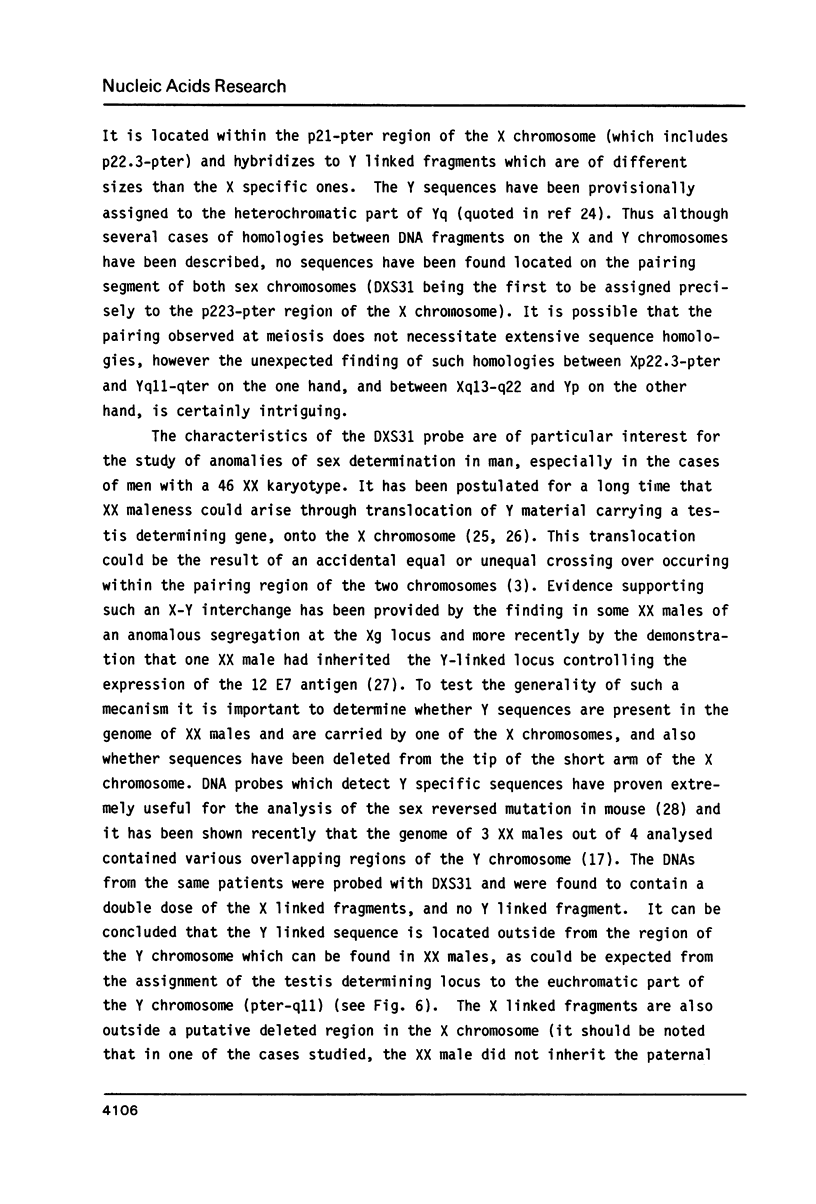
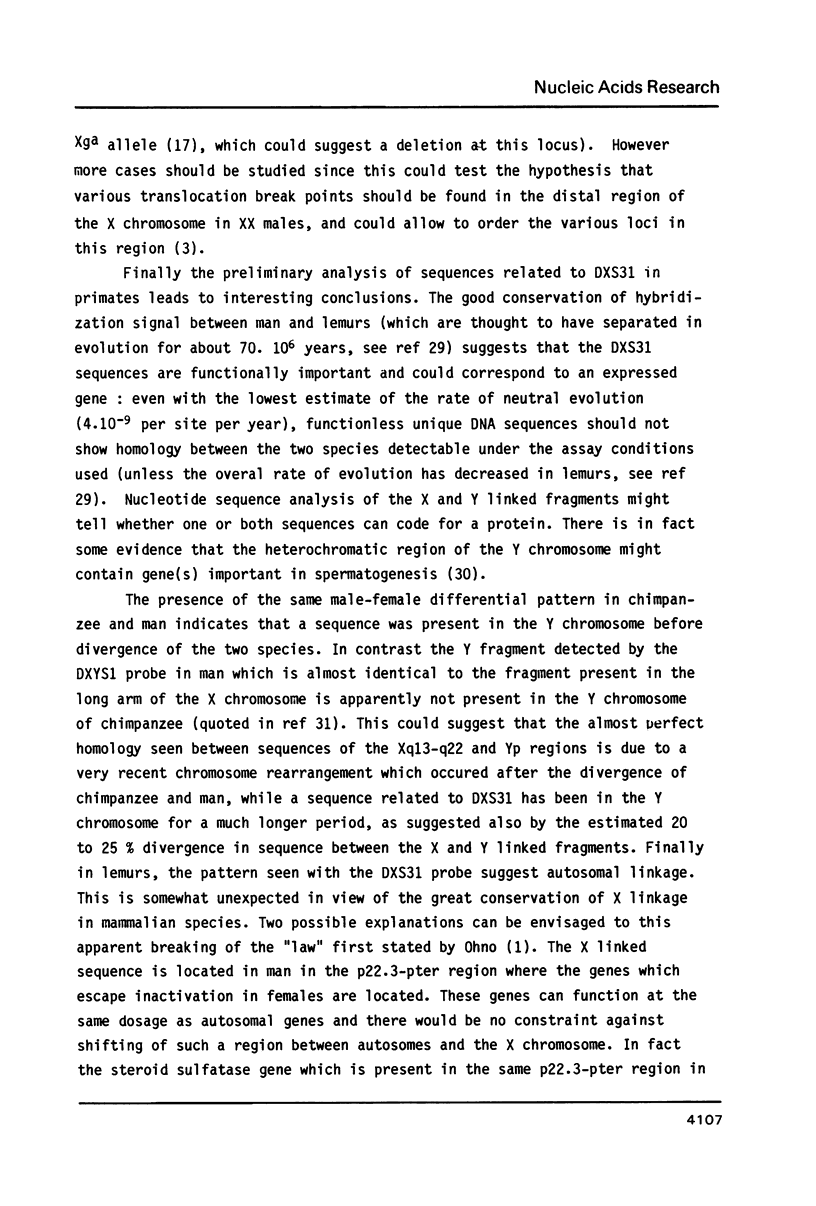
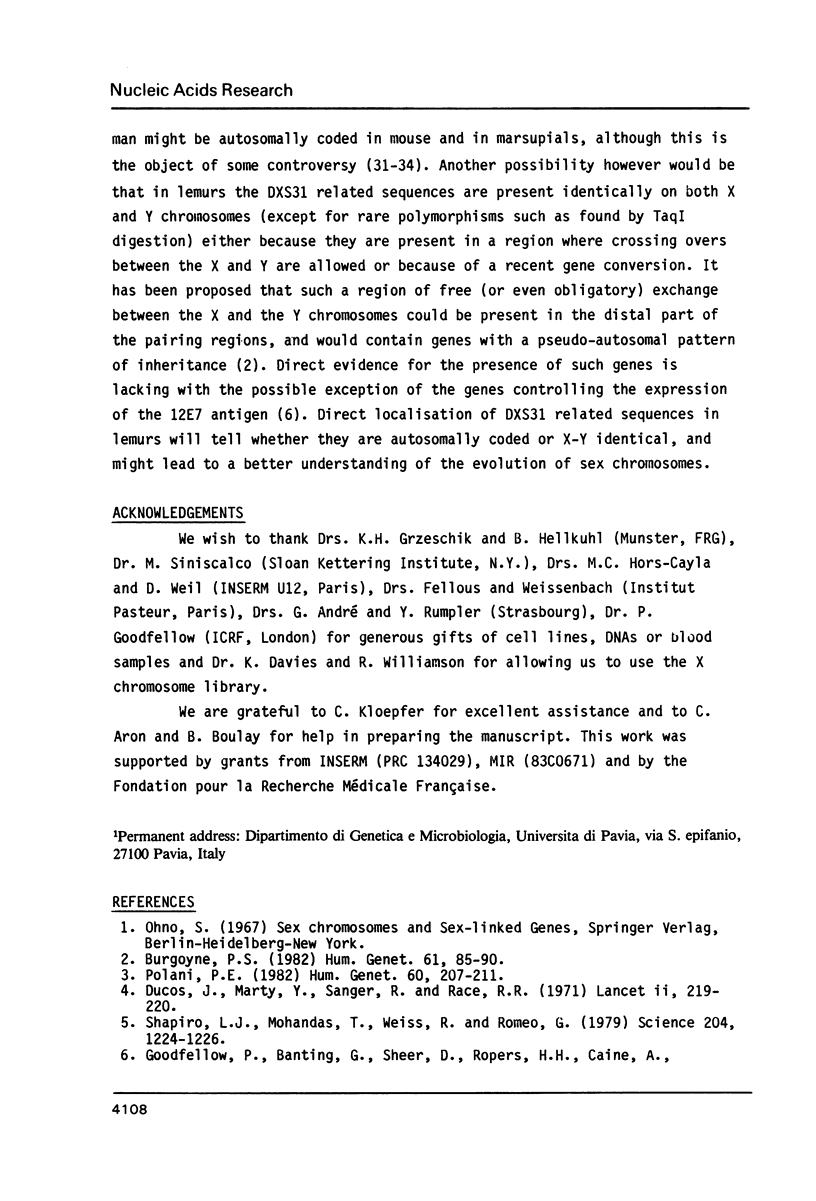
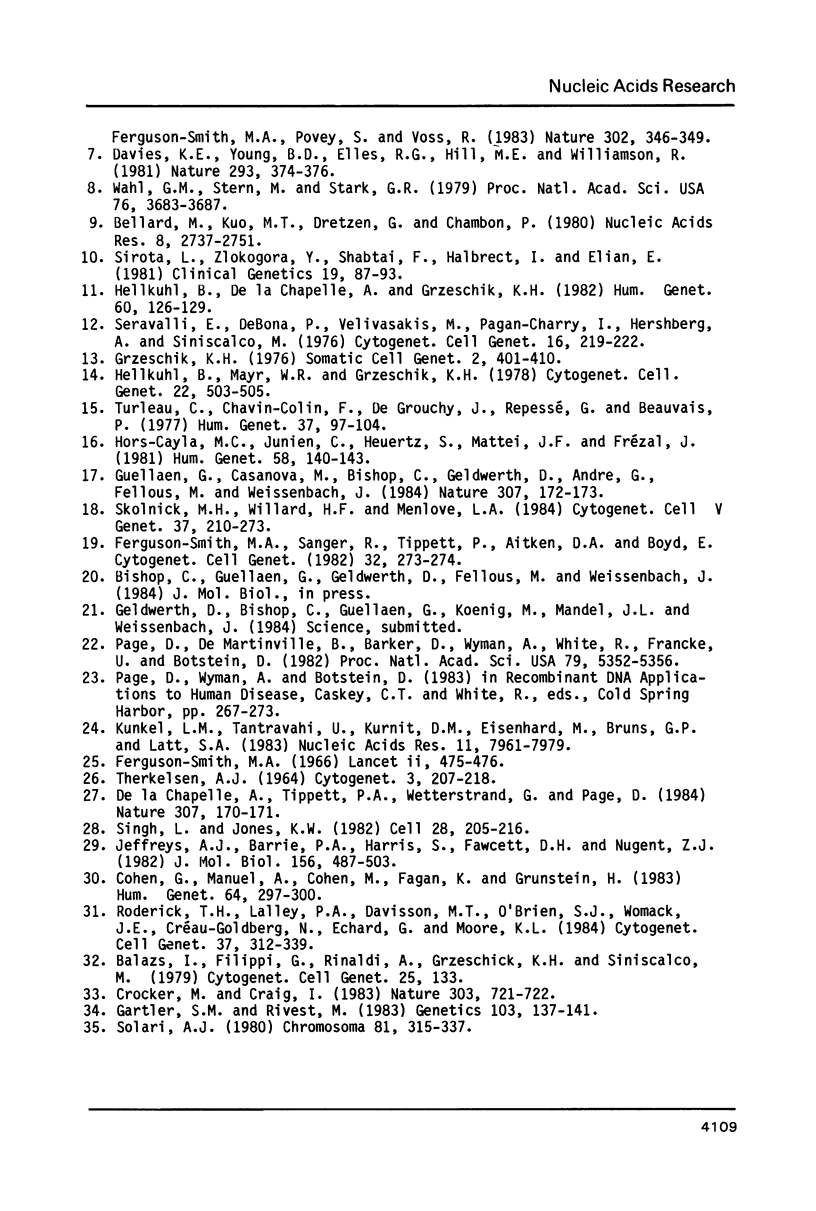
Images in this article
Selected References
These references are in PubMed. This may not be the complete list of references from this article.
- Bellard M., Kuo M. T., Dretzen G., Chambon P. Differential nuclease sensitivity of the ovalbumin and beta-globin chromatin regions in erythrocytes and oviduct cells of laying hen. Nucleic Acids Res. 1980 Jun 25;8(12):2737–2750. doi: 10.1093/nar/8.12.2737. [DOI] [PMC free article] [PubMed] [Google Scholar]
- Burgoyne P. S. Genetic homology and crossing over in the X and Y chromosomes of Mammals. Hum Genet. 1982;61(2):85–90. doi: 10.1007/BF00274192. [DOI] [PubMed] [Google Scholar]
- Cohen G., Manuel A., Cohen M., Fagan K., Grunstein H. A deletion of heterochromatin only of the Y chromosome in an azoospermic male. Hum Genet. 1983;64(3):297–300. doi: 10.1007/BF00279416. [DOI] [PubMed] [Google Scholar]
- Crocker M., Craig I. Variation in regulation of steroid sulphatase locus in mammals. Nature. 1983 Jun 23;303(5919):721–722. doi: 10.1038/303721a0. [DOI] [PubMed] [Google Scholar]
- Davies K. E., Young B. D., Elles R. G., Hill M. E., Williamson R. Cloning of a representative genomic library of the human X chromosome after sorting by flow cytometry. Nature. 1981 Oct 1;293(5831):374–376. doi: 10.1038/293374a0. [DOI] [PubMed] [Google Scholar]
- Ducos J., Marty Y., Sanger R., Race R. R. X g and X chromosome inactivation. Lancet. 1971 Jul 24;2(7717):219–220. doi: 10.1016/s0140-6736(71)90935-4. [DOI] [PubMed] [Google Scholar]
- Ferguson-Smith M. A. X-Y chromosomal interchange in the aetiology of true hermaphroditism and of XX Klinefelter's syndrome. Lancet. 1966 Aug 27;2(7461):475–476. doi: 10.1016/s0140-6736(66)92778-4. [DOI] [PubMed] [Google Scholar]
- Gartler S. M., Rivest M. Evidence for X-linkage of steroid sulfatase in the mouse: steroid sulfatase levels in oocytes of XX and XO mice. Genetics. 1983 Jan;103(1):137–141. doi: 10.1093/genetics/103.1.137. [DOI] [PMC free article] [PubMed] [Google Scholar]
- Goodfellow P., Banting G., Sheer D., Ropers H. H., Caine A., Ferguson-Smith M. A., Povey S., Voss R. Genetic evidence that a Y-linked gene in man is homologous to a gene on the X chromosome. Nature. 1983 Mar 24;302(5906):346–349. doi: 10.1038/302346a0. [DOI] [PubMed] [Google Scholar]
- Grzeschik K. H. Assignment of a structural gene for beta-glucuronidase to human chromosome C7. Somatic Cell Genet. 1976 Sep;2(5):401–410. doi: 10.1007/BF01542721. [DOI] [PubMed] [Google Scholar]
- Guellaen G., Casanova M., Bishop C., Geldwerth D., Andre G., Fellous M., Weissenbach J. Human XX males with Y single-copy DNA fragments. Nature. 1984 Jan 12;307(5947):172–173. doi: 10.1038/307172a0. [DOI] [PubMed] [Google Scholar]
- Hellkuhl B., Mayr W. R., Grzeschik K. H. Localization of MPI, PKM2, IDHM, and the alpha subunit of hexosaminidase (HEXA) to the q21 leads to qter region of human chromosome 15. Cytogenet Cell Genet. 1978;22(1-6):503–505. doi: 10.1159/000131008. [DOI] [PubMed] [Google Scholar]
- Hellkuhl B., de la Chapelle A., Grzeschik K. H. Different patterns of X chromosome inactivity in lymphocytes and fibroblasts of a human balanced X;autosome translocation. Hum Genet. 1982;60(2):126–129. doi: 10.1007/BF00569697. [DOI] [PubMed] [Google Scholar]
- Hors-Cayla M. C., Junien C., Heuertz S., Mattei J. F., Frézal J. Regional assignment of arylsulfatase A, mitochondrial aconitase and NADH-cytochrome b5 reductase by somatic cell hybridization. Hum Genet. 1981;58(2):140–143. doi: 10.1007/BF00278698. [DOI] [PubMed] [Google Scholar]
- Jeffreys A. J., Barrie P. A., Harris S., Fawcett D. H., Nugent Z. J., Boyd A. C. Isolation and sequence analysis of a hybrid delta-globin pseudogene from the brown lemur. J Mol Biol. 1982 Apr 15;156(3):487–503. doi: 10.1016/0022-2836(82)90262-5. [DOI] [PubMed] [Google Scholar]
- Kunkel L. M., Tantravahi U., Kurnit D. M., Eisenhard M., Bruns G. P., Latt S. A. Identification and isolation of transcribed human X chromosome DNA sequences. Nucleic Acids Res. 1983 Nov 25;11(22):7961–7979. doi: 10.1093/nar/11.22.7961. [DOI] [PMC free article] [PubMed] [Google Scholar]
- Page D., de Martinville B., Barker D., Wyman A., White R., Francke U., Botstein D. Single-copy sequence hybridizes to polymorphic and homologous loci on human X and Y chromosomes. Proc Natl Acad Sci U S A. 1982 Sep;79(17):5352–5356. doi: 10.1073/pnas.79.17.5352. [DOI] [PMC free article] [PubMed] [Google Scholar]
- Polani P. E. Pairing of X and Y chromosomes, non-inactivation of X-linked genes, and the maleness factor. Hum Genet. 1982;60(3):207–211. doi: 10.1007/BF00303003. [DOI] [PubMed] [Google Scholar]
- Roderick T. H., Lalley P. A., Davisson M. T., O'Brien S. J., Womack J. E., Créau-Goldberg N., Echard G., Moore K. L. Report of the Committee on Comparative Mapping. Cytogenet Cell Genet. 1984;37(1-4):312–339. doi: 10.1159/000132013. [DOI] [PubMed] [Google Scholar]
- Seravalli E., DeBona P., Velivasakis M., Pagan-Charry I., Hershberg A., Siniscalco M. Further data on the cytologic mapping of the human X chromosome with man-mouse cell hybrids. Cytogenet Cell Genet. 1976;16(1-5):219–222. doi: 10.1159/000130595. [DOI] [PubMed] [Google Scholar]
- Shapiro L. J., Mohandas T., Weiss R., Romeo G. Non-inactivation of an x-chromosome locus in man. Science. 1979 Jun 15;204(4398):1224–1226. doi: 10.1126/science.156396. [DOI] [PubMed] [Google Scholar]
- Singh L., Jones K. W. Sex reversal in the mouse (Mus musculus) is caused by a recurrent nonreciprocal crossover involving the x and an aberrant y chromosome. Cell. 1982 Feb;28(2):205–216. doi: 10.1016/0092-8674(82)90338-5. [DOI] [PubMed] [Google Scholar]
- Sirota L., Zlotogora Y., Shabtai F., Halbrecht I., Elian E. 49,XYYYY. A case report. Clin Genet. 1981 Feb;19(2):87–93. doi: 10.1111/j.1399-0004.1981.tb00676.x. [DOI] [PubMed] [Google Scholar]
- Skolnick M. H., Willard H. F., Menlove L. A. Report of the Committee on Human Gene Mapping by Recombinant DNA Techniques. Cytogenet Cell Genet. 1984;37(1-4):210–273. doi: 10.1159/000132011. [DOI] [PubMed] [Google Scholar]
- Solari A. J. Synaptosomal complexes and associated structures in microspread human spermatocytes. Chromosoma. 1980;81(3):315–337. doi: 10.1007/BF00368145. [DOI] [PubMed] [Google Scholar]
- THERKELSEN A. J. STERILE MALE WITH THE CHROMOSOME CONSTITUTION 46 XX. Cytogenetics. 1964;3:207–218. doi: 10.1159/000129812. [DOI] [PubMed] [Google Scholar]
- Turleau C., Chavin-Colin F., de Grouchy J., Repessé G., Beauvais P. Familial t(X;2) (p223;q323) with partial trisomy 2q and male and female balanced carriers. Hum Genet. 1977 Jun 10;37(1):97–104. doi: 10.1007/BF00293779. [DOI] [PubMed] [Google Scholar]
- Wahl G. M., Stern M., Stark G. R. Efficient transfer of large DNA fragments from agarose gels to diazobenzyloxymethyl-paper and rapid hybridization by using dextran sulfate. Proc Natl Acad Sci U S A. 1979 Aug;76(8):3683–3687. doi: 10.1073/pnas.76.8.3683. [DOI] [PMC free article] [PubMed] [Google Scholar]
- de la Chapelle A., Tippett P. A., Wetterstrand G., Page D. Genetic evidence of X-Y interchange in a human XX male. Nature. 1984 Jan 12;307(5947):170–171. doi: 10.1038/307170a0. [DOI] [PubMed] [Google Scholar]



